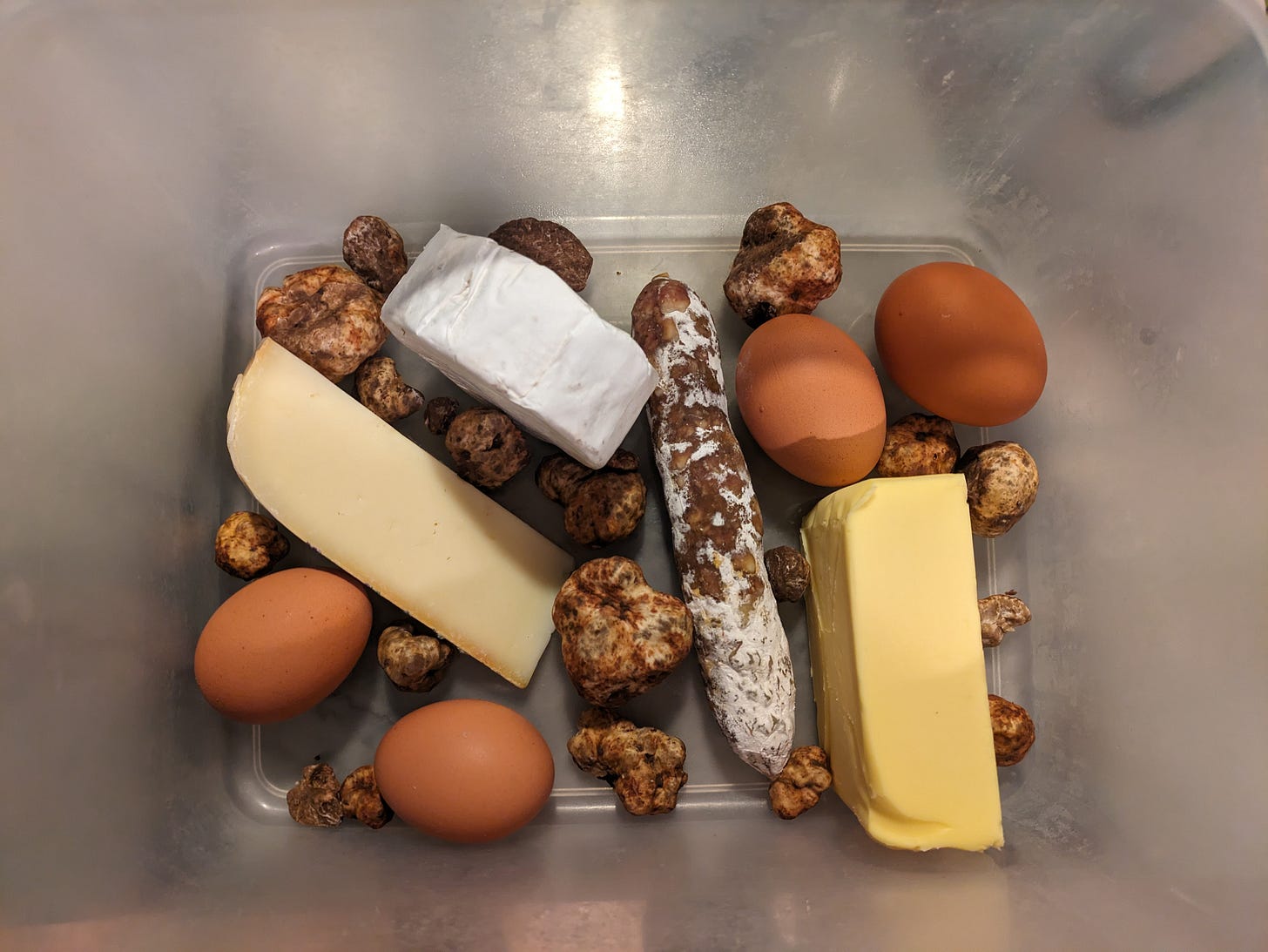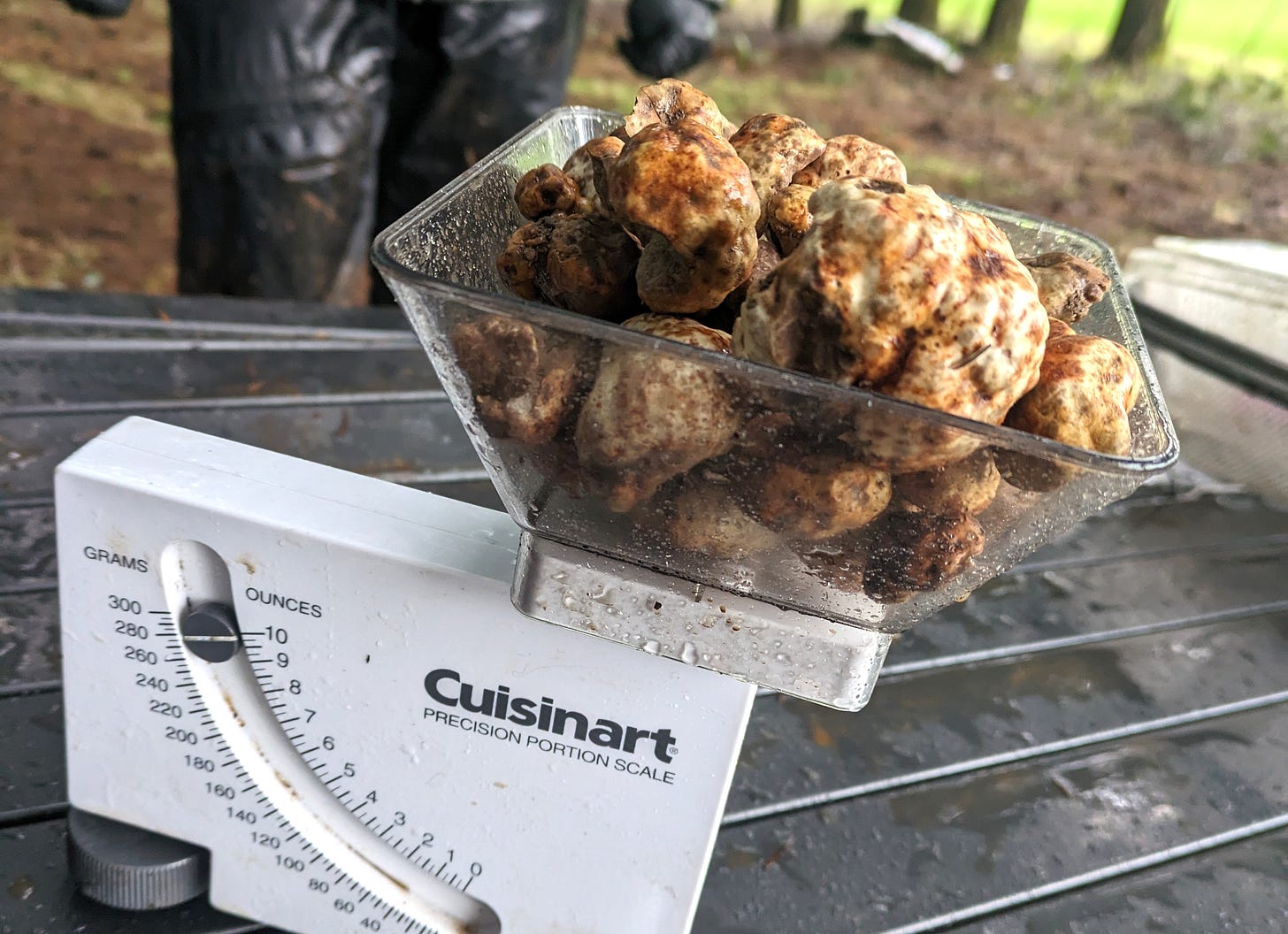Entering a petite grove of Douglas Fir pine trees in Sherwood, Oregon, Joey, a yellow labrador, gracefully glides across the forest floor to a spot and starts digging quickly with his paws, his nose firmly pressed to the ground. In mere seconds, his deft paws reach a depth of four to six inches, and the white truffles are exposed. Joey munches away at the delicacy. Better luck next time for us.
All my adult life, I have dreamed of truffle hunting—with pigs or dogs, it didn’t matter to me. I thought I would have to cross the Atlantic Ocean to Trieste, Italy, or somewhere in Slovenia or Croatia, making it all the more fanciful. Alas, the seasons have never aligned for me to visit those places yet.
Sitting on an Alaska Airlines flight from San Francisco to Portland, I spoke with a newfound neighbor whose family has lived in Portland for generations on a carved-out 20-acre plot in the Germantown neighborhood, a highly forested area at the edge of the city limits. The talk of wine led to foraging and the revelation that truffles grew all over the Portland area.
Every time I walk out the door where I live on the edge of Forest Park, visible mushrooms abound in three out of the four seasons. Growing on the side of rocks, tree stumps, popping out of the grass, clumped together, emerging from the dirt, but I had never known about truffles (except for the Pig movie a few years ago, which could have been a myth).
Portland, Oregon, is at the same latitude as Trieste, Italy, the famed spot for truffle hunting. Both have annual rainfalls between 36 and 40 inches, similar average temperatures, and abundant forests, making them ideal conditions for truffle growing.
In Oregon, white truffles thrive in small forest acreage with low understory (not much shrubbery on the forest floor). Secret locations exist throughout the Portland, Oregon area. We were asked to turn off our location on our phones. The location was somewhere in the Sherwood Forest, which makes it even more intriguing considering Robin Hood and its distribution of wealth - its namesake. White truffles sell for over $800 a pound for the Oregon varietal and over $7,000 a pound for the Italian Alba truffles. If properly stored, the truffles last two weeks before they develop white fuzzy mold spots and ooze out their essence.
The frigid rainy day enhances the pungent aroma, and Joey quickly locates the truffles underground. Braving the elements of rain and cold yields more treasure than sunny weather. Now for the dirty work: Joey starts moving his claws back and forth as his nose plunges into the ground. We move his snout aside to reveal roseate worms weaving through the soil, and we take our gloved hands and claw back the dirt to uncover the truffle or truffles.
If hand digging isn’t successful, we take a small garden shovel and disrupt the dirt ten inches away from the spot so we don’t break the truffle apart. The shovel may hit a mouse hole or other rodent cave buried under the soil. It happens that rodents have a symbiotic relationship with truffles. The rodent’s love of truffles turns into more truffles thanks to their poop, which drops truffle spores for them to grow again. More clawing away at the mud, the portion of the truffle is revealed. Carefully like an archaeologist who has discovered a million-year-old fossil, we gingerly extract the truffle from its hiding place.
Drenched cold but not frozen soil fosters the growth of white truffles. The mushrooms tend to sprout under the soil around trees roots. Joey darts from one spot to another until his fill of truffles or the smell starts to overload his senses, much akin to visiting a perfume bar.
After being pounded by freezing rain for an hour and a half of hunting, our euphoria of unearthing white truffles subsides. We realize that our “waterproof” pants and jackets are, in fact, permeable. We are frozen to the bone. Drenched down to our skivvies, I realize it’s time to get my Fal Ravn hiking pants and jacket re-waxed.
Cleaning the truffles takes as long as finding them. We tried to get our frozen fingers to work again as a scale, two shallow pails of water, a cup of toothbrushes, and a clean towel-lined container were set onto a portable table on the forest floor.
The truffles were dropped a few at a time into the water and hurriedly plucked out. The toothbrushes brushed away as much mud as possible, and then a paper towel gently wiped off some more. To finish drying, the truffles were placed on a clean towel. Despite the rain pelting us, we tried our best to dry them. With the cleaning completed, we weighed the bounty of truffles. With Ava and Joey as our guides, we foraged twelve ounces of white truffles—not bad for first-timers.
Ava reveals that the aroma imparts the prized flavor, not the truffle itself. On the way home, I stop to buy several blocks of European-style salted butter, a couple of wedges of cheese, a dozen eggs, and a long cylinder of salami. I place the truffle nuggets in a large airtight bin lined with paper towels. The truffles sit next to the items but do not touch each other. Within a few days, the bricks of butter transform into truffle butter. I wrap them in cheese paper and pop them in the freezer.

With up to two weeks to make the most of our truffles, we shave them off on all sorts of dishes. We enhance homemade pasta, risotto, omelets, grilled cheese, and flatbreads. An omelet becomes something otherworldly with truffle butter for the pan, truffled eggs, truffled goat cheese, and truffle shavings on top - heaven in our mouths.
Truffle Trove Storage Tips
Ensure your bin is airtight; otherwise, everything will be truffled.
Place food in the bin apart from one another.
Replace the paper towel lining daily as the truffles sweat.
The aroma is not for everyone, my son likened it to nail polish.
Historical Nuggets
Ancient Grecian thought truffles were made with a strike of Zeus’s thunderbolt.
In the Middle Ages, monks were forbidden to eat truffles because they were thought to be an aphrodisiac. Eating truffles would have resulted in them breaking the vow of chastity.
Since 1985, pigs have been outlawed from hunting truffles in Italy.







How neat to make truffle butter that way! Genius!
Truly!